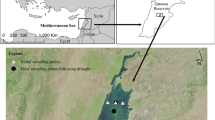Abstract
Fixed station sampling is the conventional method used to obtain data on the median water quality of reservoirs. A major source of uncertainty associated with this technique is that water quality at the fixed stations may not be representative of the ambient water quality in the reservoir at the time of sampling. This problem is particularly relevant for water quality variables such as chlorophyll, which have a markedly patchy spatial distribution. The use of Landsat reflectance data to estimate median chlorophyll concentrations in Roodeplaat Dam was investigated. A linear polynomial regression model for estimating chlorophyll concentrations from Landsat reflectance data, was firstly calibrated with chlorophyll concentration data obtained by sampling seven fixed stations on the reservoir at the time of the satellite overflight to produce an individual calibration. Secondly, the model was calibrated with a pooled set of sampled data obtained from five separate overflights, to obtain a generalised calibration.
It was found that median chlorophyll concentrations determined from Landsat-derived data were similar to median chlorophyll concentrations estimated from fixed station data. However, the range of chlorophyll concentrations in the reservoir estimated from Landsat data was considerably larger than that estimated from fixed station data. Landsat derived estimates of chlorophyll concentrations have the added advantage of providing information on the spatial distribution of chlorophyll in the reservoir.
Similar content being viewed by others
References
Chambers, J. M., Cleveland, W. S., Kleiner, B., and Tukey, P. A.: 1983, Graphical Methods for Data Analysis, Wadsworth International Group, Duxbury Press, Boston, pp. 21–63.
De Wet, J. S.: 1986, Fitoplanktonproduktiwiteit en faktore wat dit in Roodeplaatdam beïnvloed, PhD Thesis, University of the Orange Free State, pp. 1–228.
Department of Water Affairs: 1964, Hydrographic Survey Publication, No. 8, Part 1, The Government Printer, Pretoria.
Department of Water Affairs: 1979, Roodeplaat Dam Capacity Determination, Planning Division, Hydrographic Survey, Report No. S012/01/8000 A2R09.
Howman, A. M. and Kempster, P. L.: 1986, Landsat Water Quality Surveillance—Development of the Model CALMCAT, Department of Water Affairs, Technical Report TR128, Pretoria, pp. 1–196.
McGill, R., Tukey, J. W., and Larsen, W. A.: 1978, Variations of Box Plots', Am. Stat. 32, 12–16.
Sartory, D. P.: 1982, Spectrophotometric Analysis of Chlorophyll a in Freshwater Phytoplankton, Department of Environment Affairs, Technical Report TR115, Pretoria, RSA, pp. 1–163.
Steyn, D. J. and Toerien, D. F.: 1976, ‘Eutrophication Levels of some South African Impoundments in Roodeplaat Dam’, Water SA, 2, 1–6.
Walmsley, R. D. and Butty, M.: 1980, Guidelines for the Control of Eutrophication in South Africa, Water Research Commission and National Institute for Water Research (CSIR), Pretoria, pp. 1–27.
Author information
Authors and Affiliations
Rights and permissions
About this article
Cite this article
Howman, A., Grobler, D., Kempster, P. et al. Landsat and limnologically derived water quality data: A perspective. Environ Monit Assess 13, 1–9 (1989). https://doi.org/10.1007/BF00398731
Issue Date:
DOI: https://doi.org/10.1007/BF00398731




